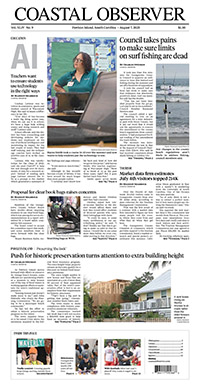Roads
Safe streets plan seeks to draw more federal funds

There were 27 people killed in collisions along Highway 17 on the Waccamaw Neck in the last decade, according to data from the S.C. Department of Public Safety. Two of those within the last month. Planners are looking for ways to reduce those numbers here and around the region in the future.
A federal Safe Streets 4 All action plan is being developed for the Grand Strand Area Transportation Study using a $725,000 grant. A public input meeting last week drew 17 people to the Waccamaw Library. An earlier meeting in Myrtle Beach drew about 25, said Mark Hoeweler, the executive director of GSATS.
The study will consider the public input as well as the data, said Ryan Eckenrode, a traffic engineer with AECOM, the Columbia-based firm developing the plan. He also worked on the 2021 study of the Highway 17 corridor on Waccamaw Neck.
“We’re not looking at all crashes, just the most serious,” he said. “We’re going to let the data lead us, but there are other quantitative factors.”
People at the meeting raised concerns about speeding, pedestrian and cyclist safety and about drivers simply not following the law.
“We still hear there are too many people moving here. That’s not really our focus,” said Elizabeth Tucker, a planner with GSATS.
The action plan, which is required by the Federal Highway Administration, will make the region eligible for funds for improvement projects. One idea Hoeweler has in mind is extending Georgetown County’s system of traffic signal controls that give fire and rescue vehicles priority into Horry County where the region’s only two trauma centers are located. The system, known as Opticom, was installed in 2021 using $1 million from surplus collected through a capital projects sales tax.
“One thing we’re looking at is what happens post-crash,” Hoeweler said.
One of the most effective safety improvements is not allowed in South Carolina by law.
“Red light cameras are the number one proven way to reduce traffic fatalities,” Hoeweler said. After they were adopted in California, fatalities dropped 20 percent.
The cameras are one of the options listed in a survey that planners are using to collect data. It is available online at gsats.org.
“That’s the only way we know what projects are near and dear to them,” Tucker said.
The survey also lets participants pinpoint areas they believe are safety concerns.
“We heard a lot about the North Causeway intersection,” Eckenrode said. That didn’t surprise him after his work on the corridor study, which proposed reconfiguring the intersection to eliminate left turns.
Of the 63,318 crashes that took place in the GSATS region between 2019 and 2023, the vast majority occurred in Horry County. There were 2,117 reported on Highway 17 on the Waccamaw Neck. There were 14 people killed, seven of them in 2023, according to the Department of Public Safety. Those were among 269 traffic fatalities reported in Georgetown and Horry counties.
“That’s 269 people who didn’t come home for dinner,” Hoeweler said. “If we could bring that down … .”
AECOM will complete a draft of the action plan with a list of proposed improvements this fall. Another round of public meetings will be held to gather comments.
Even if funding isn’t available to complete them all, the plan will become part of the criteria GSATS uses in prioritizing federal funds for road projects.
“This action plan is forever,” Tucker said.




